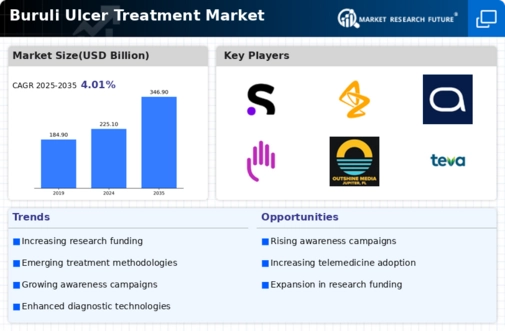Rising Public Health Awareness
Rising public health awareness regarding Buruli ulcer is significantly impacting the Buruli Ulcer Treatment Market. Educational campaigns aimed at informing communities about the disease's symptoms, transmission, and treatment options are becoming more prevalent. This increased awareness is likely to lead to earlier diagnosis and treatment, which can improve patient outcomes and reduce the disease's burden. Health organizations are actively engaging in outreach programs to educate at-risk populations, thereby fostering a proactive approach to disease management. As communities become more informed, the demand for effective treatment options is expected to rise, further driving growth in the Buruli Ulcer Treatment Market.
Rising Incidence of Buruli Ulcer
The increasing incidence of Buruli ulcer, particularly in tropical and subtropical regions, is a primary driver for the Buruli Ulcer Treatment Market. Reports indicate that the disease is prevalent in areas such as West Africa and parts of Australia, with cases rising annually. This trend necessitates enhanced treatment options and healthcare resources, thereby stimulating market growth. The World Health Organization has noted a concerning uptick in reported cases, which underscores the urgent need for effective treatment protocols. As awareness of the disease spreads, healthcare systems are compelled to allocate more resources towards managing Buruli ulcer, thus propelling the market forward. The rising incidence not only highlights the need for innovative therapies but also emphasizes the importance of early detection and intervention in the Buruli Ulcer Treatment Market.
Government Initiatives and Funding
Government initiatives aimed at combating Buruli ulcer significantly influence the Buruli Ulcer Treatment Market. Various health ministries are increasingly recognizing the need for targeted funding and resources to address this neglected tropical disease. For instance, several countries have launched national programs to improve surveillance, diagnosis, and treatment of Buruli ulcer. These initiatives often include financial support for research and development of new treatment modalities, which can lead to breakthroughs in the market. Additionally, partnerships with international organizations enhance the reach and effectiveness of these programs. The commitment of governments to allocate funds for Buruli ulcer treatment not only boosts market growth but also fosters collaboration among stakeholders, thereby enhancing the overall healthcare landscape.
Increased Research and Development
The surge in research and development activities focused on Buruli ulcer is a crucial driver for the Buruli Ulcer Treatment Market. Academic institutions and pharmaceutical companies are increasingly investing in studies aimed at understanding the disease's pathophysiology and exploring new treatment options. This heightened focus on R&D is likely to yield innovative therapies that could transform the treatment landscape. Moreover, collaborative efforts between researchers and healthcare providers are fostering a more comprehensive approach to tackling the disease. The potential for new drug discoveries and treatment protocols not only enhances the market's attractiveness but also addresses the pressing need for effective solutions in managing Buruli ulcer.
Technological Advancements in Treatment
Technological advancements in medical treatments are reshaping the Buruli Ulcer Treatment Market. Innovations such as improved diagnostic tools and novel therapeutic agents are emerging, which could potentially enhance treatment efficacy and patient outcomes. For example, the development of molecular diagnostic techniques allows for quicker and more accurate identification of the disease, facilitating timely intervention. Furthermore, research into new antibiotics and alternative therapies is ongoing, with some studies suggesting that these could significantly reduce treatment duration and improve recovery rates. As these technologies become more accessible, they are likely to drive market growth by providing healthcare professionals with better tools to combat Buruli ulcer effectively.


















Leave a Comment